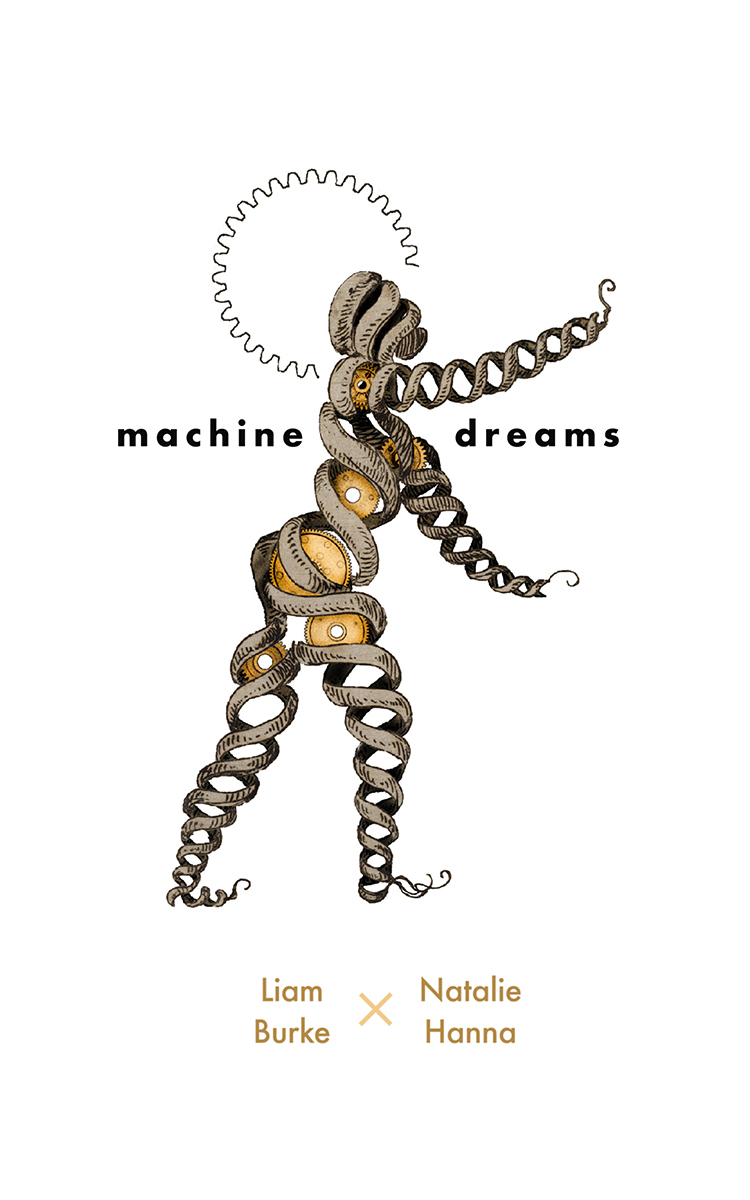
machine dreams embodies its title: a blend of sweeping surrealism and sharp-edged device (“i dreamt i was a bulldozer./ i dreamt i was an empty field.” (“request translation”)). Device in the literal sense: the many machines, mechanisms, and apparatuses which make up the chapbook, such as the iron lung in “negative pressure”: “lost time. iron lung. remember how/ the incubator neonatal; post-umbilical ventilation/ heart twinned in wax walled cell,” but also the literary devices which include the varied and vast external references as highlighted in Hanna’s reading guide. (Note: poem names cited in this review refer to those given in the reading guide.)
machine dreams pulls from a large network of sources, citing everything from steel knives to poet IAN MARTIN (“i love to love the machine that / is keeping ian martin alive” (“i love to love the machine…”)), to touch starvation. Reading the guide as you follow the chapbook feels almost like reading a blueprint as you construct a machine, interrupting your own wonder at the complex series of moving parts in order to take a step back and familiarize yourself with its inner workings. There is a beauty in both the knowing and not knowing, the reader being given the choice to examine the sums of the whole, or simply be awed by the complexities that brought this chapbook to fruition.
No poem embodies machine dreams’ precarious edge between the strict infrastructure of machine and soft vulnerability of the body better than “imagine when”: “imagine when the joints crack we come / apart inside shake and rattle, kiss, kiss / magnetic train cars, meet ourselves again.” The poem is visceral and electric, emitting an almost physical vibration that ripples until its closing line. “imagine when” picks up and carries with it the electric current that is buried within the collection as a whole. Like the way an apartment shakes when the washing machine finishes its cycle, machine dreams moves and scatters anything along its path, pulling the reader along.
Burke’s companion album of the same name begins with “delta vee (where we’re going etc. etc.),” a song which takes its time forming, starting disjointed, then slowly adding layers as it moulds from staccato into longer, fluid notes. This pairs perfectly with the introductory poem of the chapbook, beginning with broken words and long pauses, only to collide together in jarring coherency at the end of the page: “I’m made of rock and the earth is shifting. My jaw / is cleft with palate quake-quaking , kerracking” (“how this puncticulous rhythm breaks”). Like when Watson startles the crowd with his pop culture knowledge on Jeopardy, there is a stunning quality to the speaker first addressing the reader directly in machine dreams. The work takes its time gearing up, clicking into place, and then explodes with vibrancy when the gears begin to turn.
By the end of the chapbook the machine has grown almost too complex, slipping away from our perception: “the s / hell of the mach / ine no long / er per ce ives tou ch” (“the shell of the machine…”). There is a sense that this work never truly finishes. Instead it grows steadily beyond the page, becoming too complex for even the most precise of blueprints.
Olive Andrews lives in Tiohtià:ke (Montréal). Their work has been published in a number of magazines, including Plasma Dolphin and PRISM International. They are currently interning at Canthius, and will be beginning their MA at Concordia in the fall.
ARC HITS THE HEART HARD.

